The Impact of Competition Policy and Market Forces on BT PLC
VerifiedAdded on 2019/12/03
|12
|3164
|182
Case Study
AI Summary
Both monetary and fiscal policies have positive as well as negative impacts on financial decision making and other business functions of BT PLC. The company must follow EU competition policy and Enterprise Act, 2002 to meet stakeholder expectations. Market structure affects pricing and output decisions, with the UK telecom market being an oligopoly. Porter's five forces model helps analyze market forces that shape responses. Customers are the king of the market, and changes in lifestyle and demand require companies like BT PLC to adapt their business policies.
Contribute Materials
Your contribution can guide someone’s learning journey. Share your
documents today.
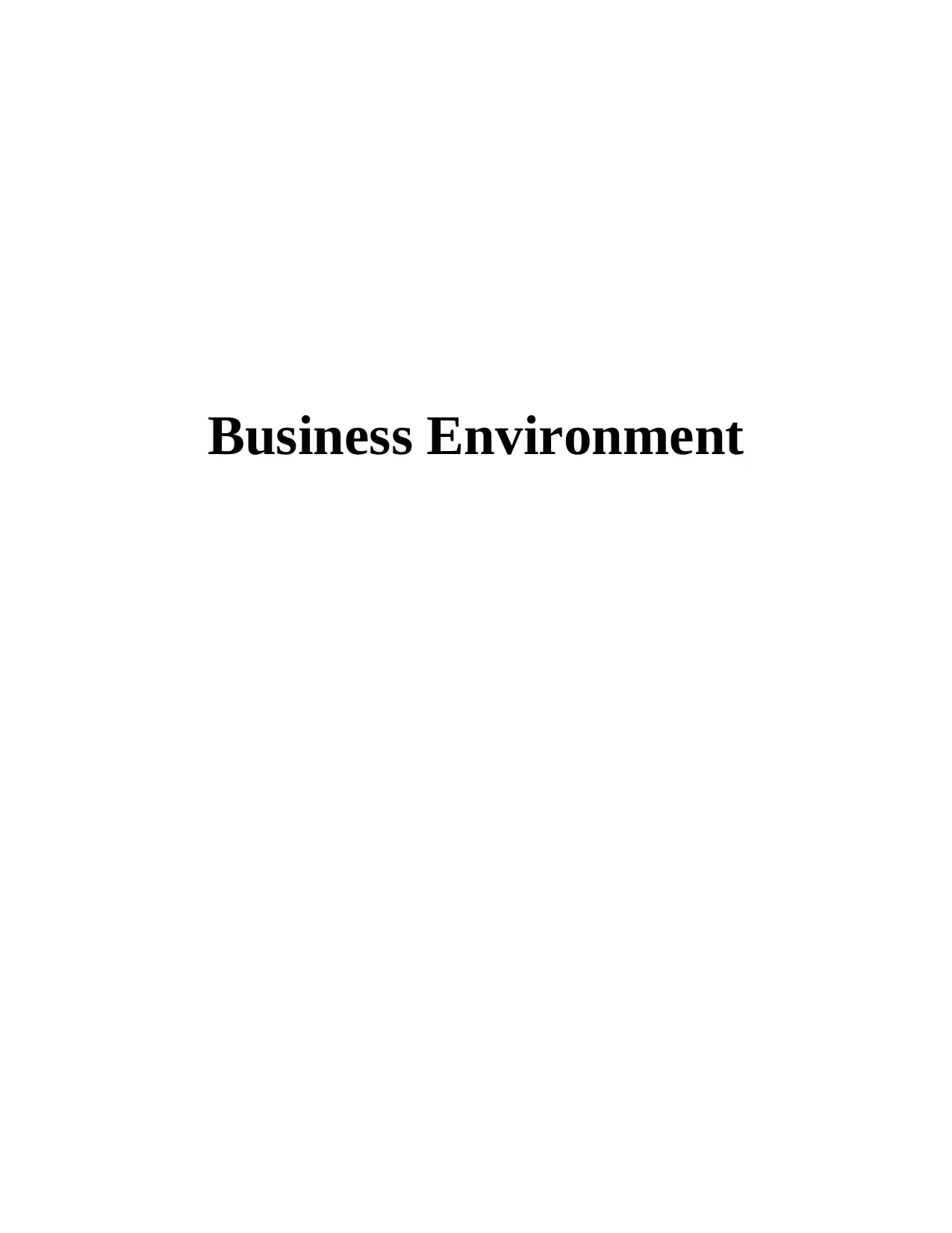
Business Environment
Secure Best Marks with AI Grader
Need help grading? Try our AI Grader for instant feedback on your assignments.
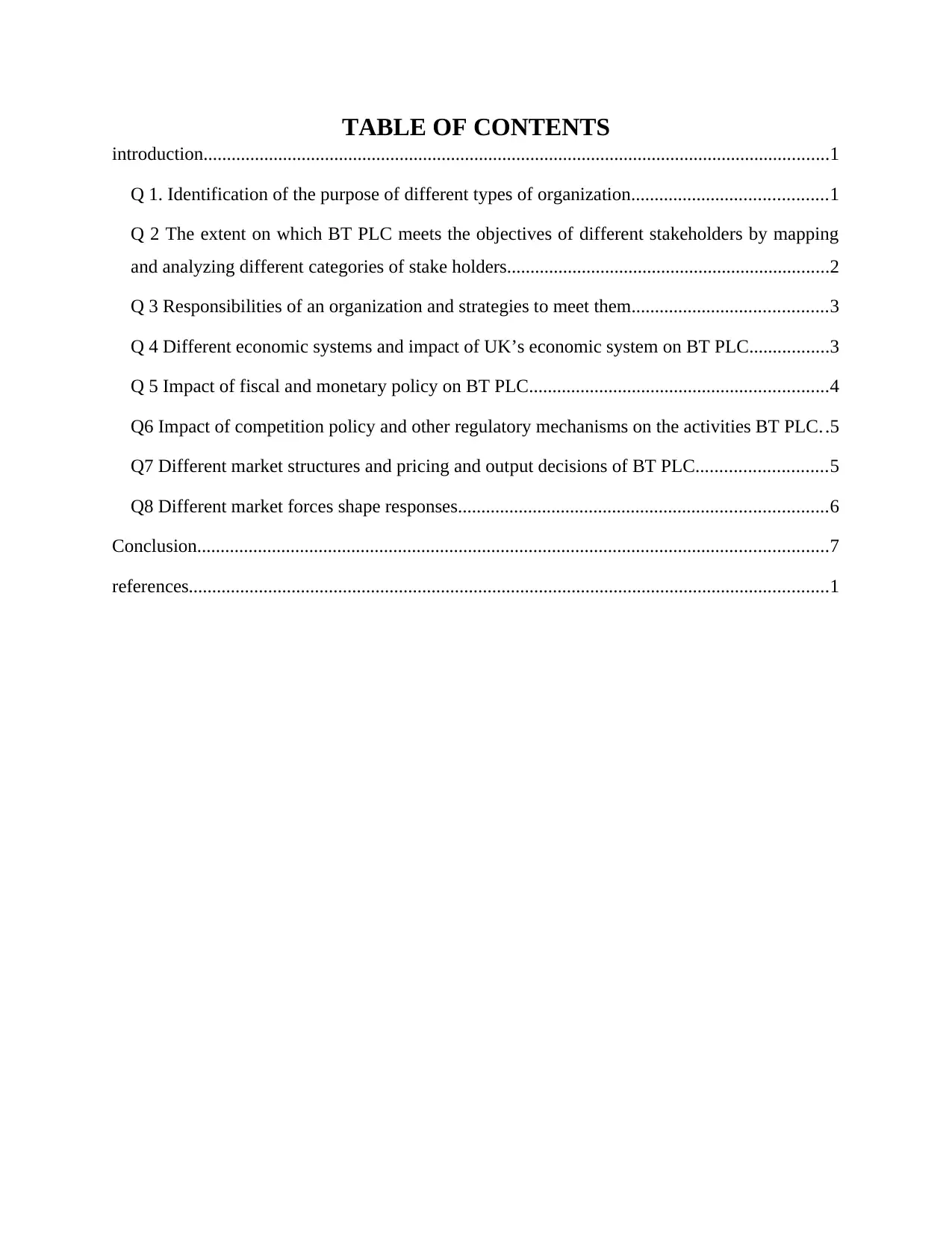
TABLE OF CONTENTS
introduction......................................................................................................................................1
Q 1. Identification of the purpose of different types of organization..........................................1
Q 2 The extent on which BT PLC meets the objectives of different stakeholders by mapping
and analyzing different categories of stake holders.....................................................................2
Q 3 Responsibilities of an organization and strategies to meet them..........................................3
Q 4 Different economic systems and impact of UK’s economic system on BT PLC.................3
Q 5 Impact of fiscal and monetary policy on BT PLC................................................................4
Q6 Impact of competition policy and other regulatory mechanisms on the activities BT PLC. .5
Q7 Different market structures and pricing and output decisions of BT PLC............................5
Q8 Different market forces shape responses...............................................................................6
Conclusion.......................................................................................................................................7
references.........................................................................................................................................1
introduction......................................................................................................................................1
Q 1. Identification of the purpose of different types of organization..........................................1
Q 2 The extent on which BT PLC meets the objectives of different stakeholders by mapping
and analyzing different categories of stake holders.....................................................................2
Q 3 Responsibilities of an organization and strategies to meet them..........................................3
Q 4 Different economic systems and impact of UK’s economic system on BT PLC.................3
Q 5 Impact of fiscal and monetary policy on BT PLC................................................................4
Q6 Impact of competition policy and other regulatory mechanisms on the activities BT PLC. .5
Q7 Different market structures and pricing and output decisions of BT PLC............................5
Q8 Different market forces shape responses...............................................................................6
Conclusion.......................................................................................................................................7
references.........................................................................................................................................1
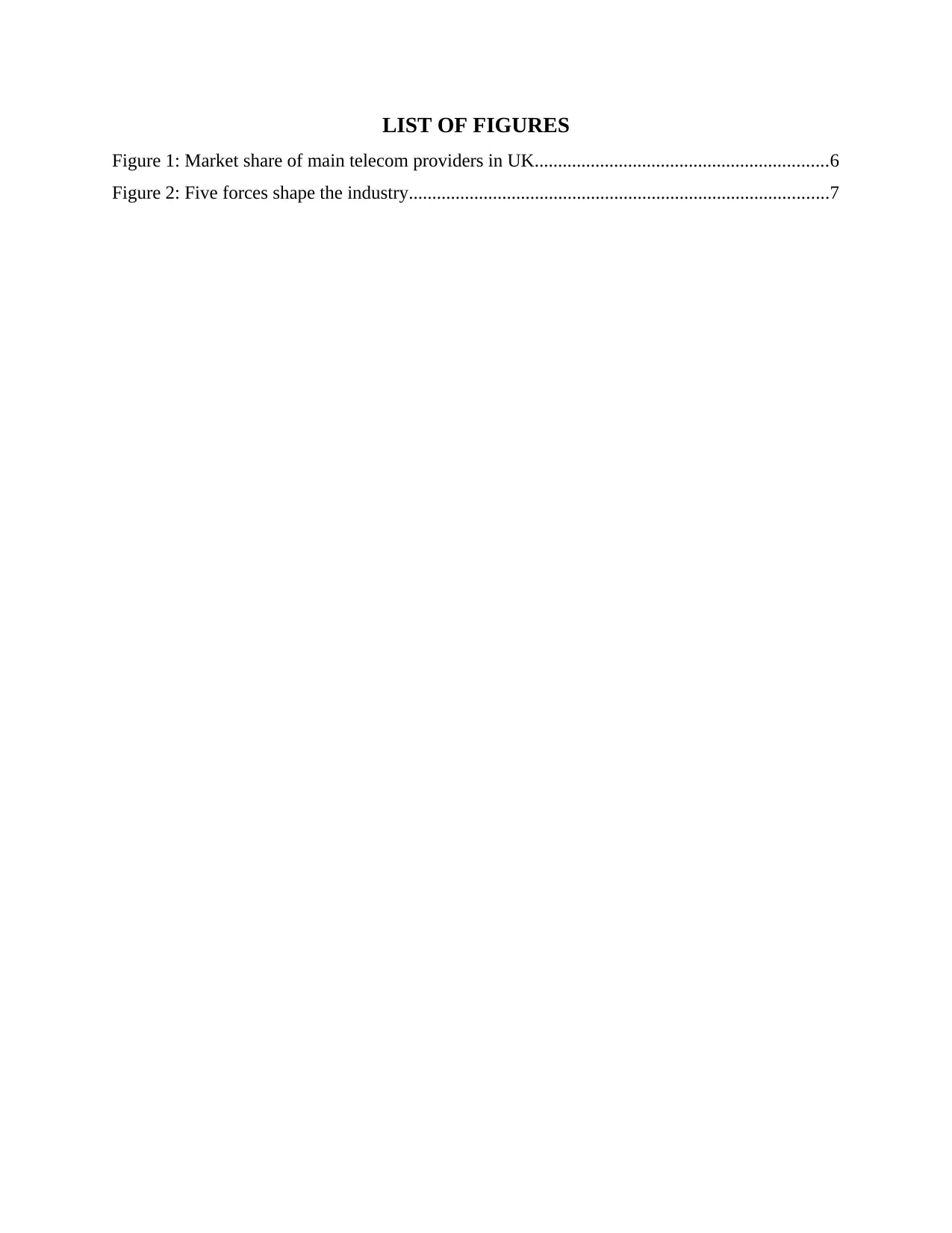
LIST OF FIGURES
Figure 1: Market share of main telecom providers in UK...............................................................6
Figure 2: Five forces shape the industry..........................................................................................7
Figure 1: Market share of main telecom providers in UK...............................................................6
Figure 2: Five forces shape the industry..........................................................................................7
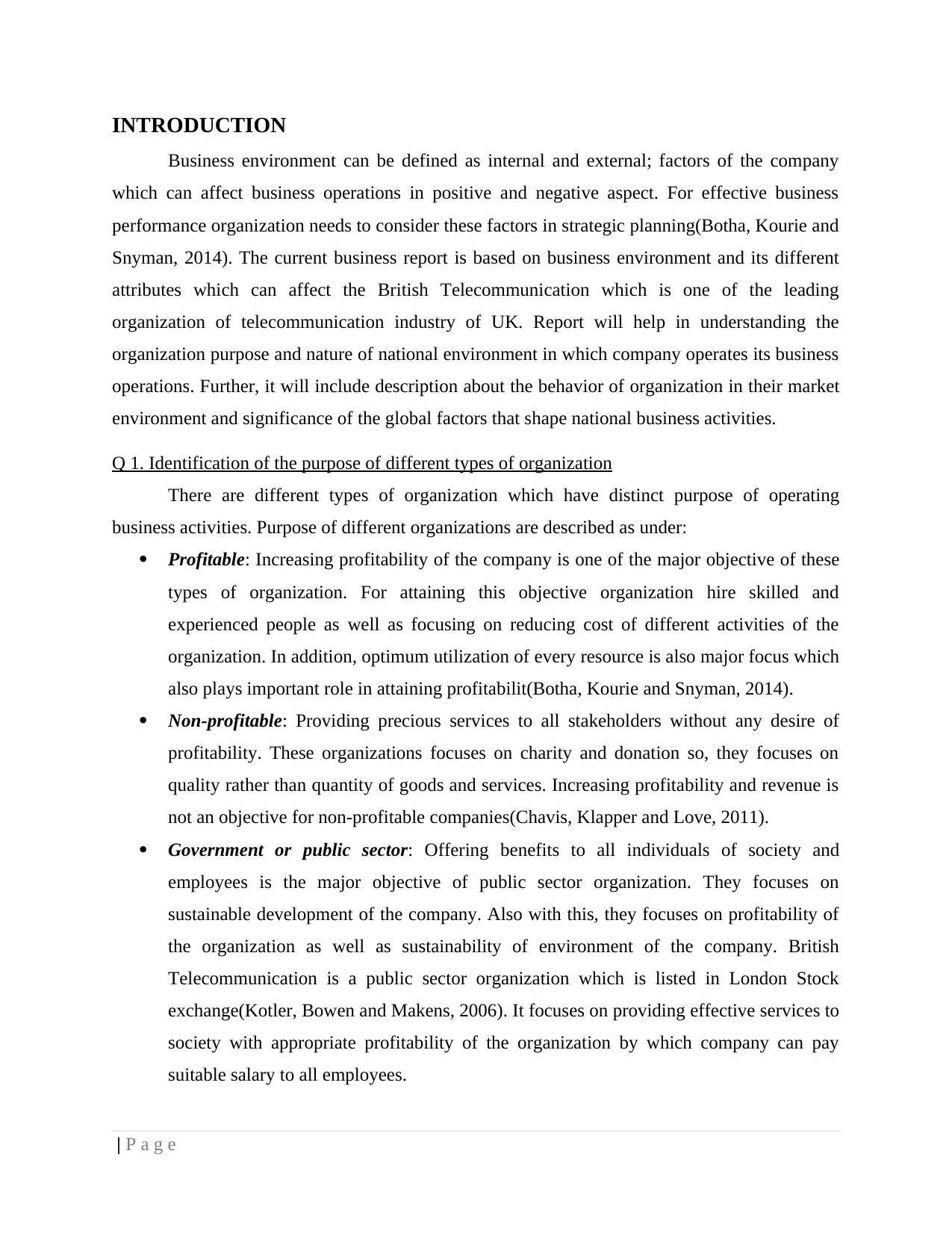
INTRODUCTION
Business environment can be defined as internal and external; factors of the company
which can affect business operations in positive and negative aspect. For effective business
performance organization needs to consider these factors in strategic planning(Botha, Kourie and
Snyman, 2014). The current business report is based on business environment and its different
attributes which can affect the British Telecommunication which is one of the leading
organization of telecommunication industry of UK. Report will help in understanding the
organization purpose and nature of national environment in which company operates its business
operations. Further, it will include description about the behavior of organization in their market
environment and significance of the global factors that shape national business activities.
Q 1. Identification of the purpose of different types of organization
There are different types of organization which have distinct purpose of operating
business activities. Purpose of different organizations are described as under:
Profitable: Increasing profitability of the company is one of the major objective of these
types of organization. For attaining this objective organization hire skilled and
experienced people as well as focusing on reducing cost of different activities of the
organization. In addition, optimum utilization of every resource is also major focus which
also plays important role in attaining profitabilit(Botha, Kourie and Snyman, 2014).
Non-profitable: Providing precious services to all stakeholders without any desire of
profitability. These organizations focuses on charity and donation so, they focuses on
quality rather than quantity of goods and services. Increasing profitability and revenue is
not an objective for non-profitable companies(Chavis, Klapper and Love, 2011).
Government or public sector: Offering benefits to all individuals of society and
employees is the major objective of public sector organization. They focuses on
sustainable development of the company. Also with this, they focuses on profitability of
the organization as well as sustainability of environment of the company. British
Telecommunication is a public sector organization which is listed in London Stock
exchange(Kotler, Bowen and Makens, 2006). It focuses on providing effective services to
society with appropriate profitability of the organization by which company can pay
suitable salary to all employees.
| P a g e
Business environment can be defined as internal and external; factors of the company
which can affect business operations in positive and negative aspect. For effective business
performance organization needs to consider these factors in strategic planning(Botha, Kourie and
Snyman, 2014). The current business report is based on business environment and its different
attributes which can affect the British Telecommunication which is one of the leading
organization of telecommunication industry of UK. Report will help in understanding the
organization purpose and nature of national environment in which company operates its business
operations. Further, it will include description about the behavior of organization in their market
environment and significance of the global factors that shape national business activities.
Q 1. Identification of the purpose of different types of organization
There are different types of organization which have distinct purpose of operating
business activities. Purpose of different organizations are described as under:
Profitable: Increasing profitability of the company is one of the major objective of these
types of organization. For attaining this objective organization hire skilled and
experienced people as well as focusing on reducing cost of different activities of the
organization. In addition, optimum utilization of every resource is also major focus which
also plays important role in attaining profitabilit(Botha, Kourie and Snyman, 2014).
Non-profitable: Providing precious services to all stakeholders without any desire of
profitability. These organizations focuses on charity and donation so, they focuses on
quality rather than quantity of goods and services. Increasing profitability and revenue is
not an objective for non-profitable companies(Chavis, Klapper and Love, 2011).
Government or public sector: Offering benefits to all individuals of society and
employees is the major objective of public sector organization. They focuses on
sustainable development of the company. Also with this, they focuses on profitability of
the organization as well as sustainability of environment of the company. British
Telecommunication is a public sector organization which is listed in London Stock
exchange(Kotler, Bowen and Makens, 2006). It focuses on providing effective services to
society with appropriate profitability of the organization by which company can pay
suitable salary to all employees.
| P a g e
Secure Best Marks with AI Grader
Need help grading? Try our AI Grader for instant feedback on your assignments.
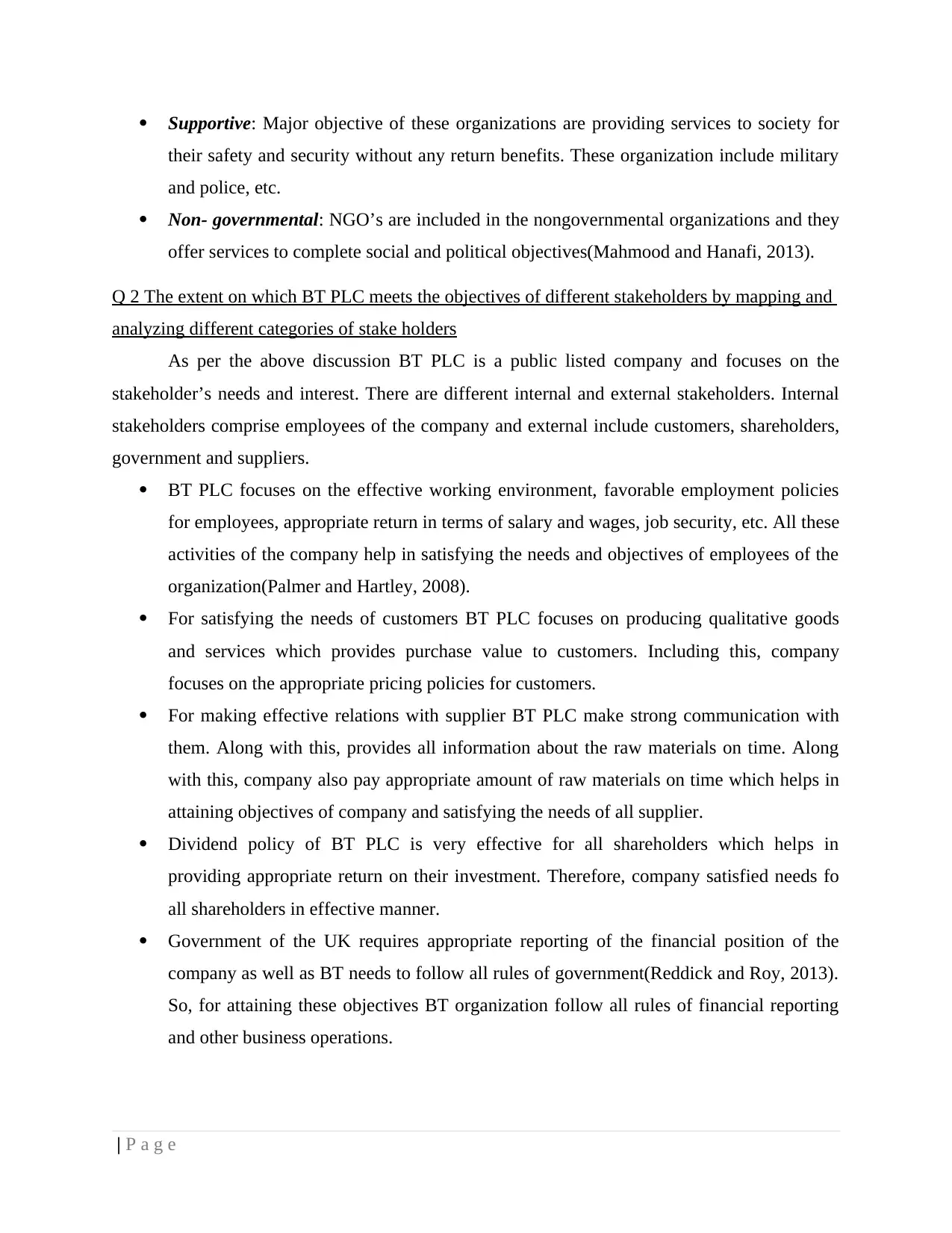
Supportive: Major objective of these organizations are providing services to society for
their safety and security without any return benefits. These organization include military
and police, etc.
Non- governmental: NGO’s are included in the nongovernmental organizations and they
offer services to complete social and political objectives(Mahmood and Hanafi, 2013).
Q 2 The extent on which BT PLC meets the objectives of different stakeholders by mapping and
analyzing different categories of stake holders
As per the above discussion BT PLC is a public listed company and focuses on the
stakeholder’s needs and interest. There are different internal and external stakeholders. Internal
stakeholders comprise employees of the company and external include customers, shareholders,
government and suppliers.
BT PLC focuses on the effective working environment, favorable employment policies
for employees, appropriate return in terms of salary and wages, job security, etc. All these
activities of the company help in satisfying the needs and objectives of employees of the
organization(Palmer and Hartley, 2008).
For satisfying the needs of customers BT PLC focuses on producing qualitative goods
and services which provides purchase value to customers. Including this, company
focuses on the appropriate pricing policies for customers.
For making effective relations with supplier BT PLC make strong communication with
them. Along with this, provides all information about the raw materials on time. Along
with this, company also pay appropriate amount of raw materials on time which helps in
attaining objectives of company and satisfying the needs of all supplier.
Dividend policy of BT PLC is very effective for all shareholders which helps in
providing appropriate return on their investment. Therefore, company satisfied needs fo
all shareholders in effective manner.
Government of the UK requires appropriate reporting of the financial position of the
company as well as BT needs to follow all rules of government(Reddick and Roy, 2013).
So, for attaining these objectives BT organization follow all rules of financial reporting
and other business operations.
| P a g e
their safety and security without any return benefits. These organization include military
and police, etc.
Non- governmental: NGO’s are included in the nongovernmental organizations and they
offer services to complete social and political objectives(Mahmood and Hanafi, 2013).
Q 2 The extent on which BT PLC meets the objectives of different stakeholders by mapping and
analyzing different categories of stake holders
As per the above discussion BT PLC is a public listed company and focuses on the
stakeholder’s needs and interest. There are different internal and external stakeholders. Internal
stakeholders comprise employees of the company and external include customers, shareholders,
government and suppliers.
BT PLC focuses on the effective working environment, favorable employment policies
for employees, appropriate return in terms of salary and wages, job security, etc. All these
activities of the company help in satisfying the needs and objectives of employees of the
organization(Palmer and Hartley, 2008).
For satisfying the needs of customers BT PLC focuses on producing qualitative goods
and services which provides purchase value to customers. Including this, company
focuses on the appropriate pricing policies for customers.
For making effective relations with supplier BT PLC make strong communication with
them. Along with this, provides all information about the raw materials on time. Along
with this, company also pay appropriate amount of raw materials on time which helps in
attaining objectives of company and satisfying the needs of all supplier.
Dividend policy of BT PLC is very effective for all shareholders which helps in
providing appropriate return on their investment. Therefore, company satisfied needs fo
all shareholders in effective manner.
Government of the UK requires appropriate reporting of the financial position of the
company as well as BT needs to follow all rules of government(Reddick and Roy, 2013).
So, for attaining these objectives BT organization follow all rules of financial reporting
and other business operations.
| P a g e
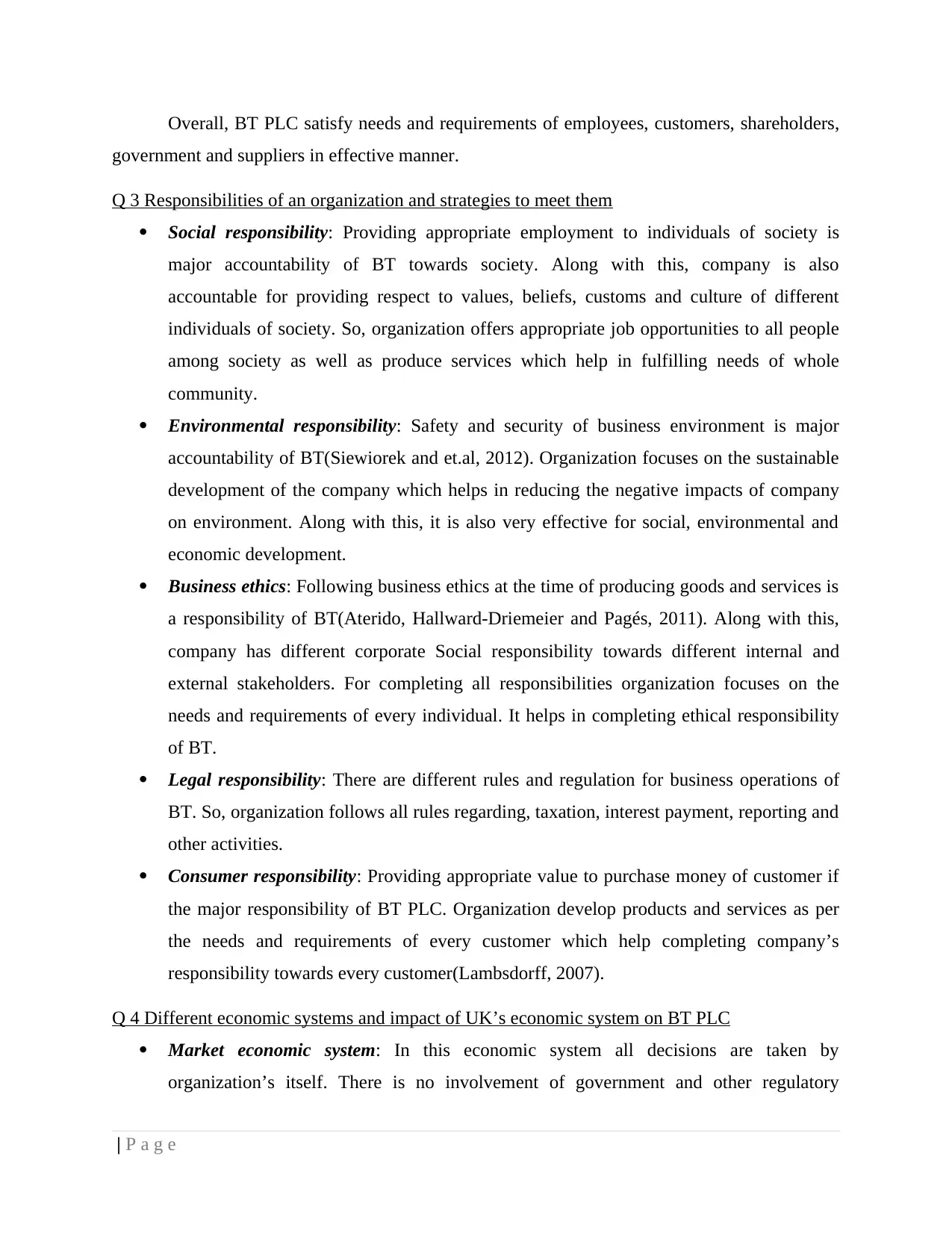
Overall, BT PLC satisfy needs and requirements of employees, customers, shareholders,
government and suppliers in effective manner.
Q 3 Responsibilities of an organization and strategies to meet them
Social responsibility: Providing appropriate employment to individuals of society is
major accountability of BT towards society. Along with this, company is also
accountable for providing respect to values, beliefs, customs and culture of different
individuals of society. So, organization offers appropriate job opportunities to all people
among society as well as produce services which help in fulfilling needs of whole
community.
Environmental responsibility: Safety and security of business environment is major
accountability of BT(Siewiorek and et.al, 2012). Organization focuses on the sustainable
development of the company which helps in reducing the negative impacts of company
on environment. Along with this, it is also very effective for social, environmental and
economic development.
Business ethics: Following business ethics at the time of producing goods and services is
a responsibility of BT(Aterido, Hallward-Driemeier and Pagés, 2011). Along with this,
company has different corporate Social responsibility towards different internal and
external stakeholders. For completing all responsibilities organization focuses on the
needs and requirements of every individual. It helps in completing ethical responsibility
of BT.
Legal responsibility: There are different rules and regulation for business operations of
BT. So, organization follows all rules regarding, taxation, interest payment, reporting and
other activities.
Consumer responsibility: Providing appropriate value to purchase money of customer if
the major responsibility of BT PLC. Organization develop products and services as per
the needs and requirements of every customer which help completing company’s
responsibility towards every customer(Lambsdorff, 2007).
Q 4 Different economic systems and impact of UK’s economic system on BT PLC
Market economic system: In this economic system all decisions are taken by
organization’s itself. There is no involvement of government and other regulatory
| P a g e
government and suppliers in effective manner.
Q 3 Responsibilities of an organization and strategies to meet them
Social responsibility: Providing appropriate employment to individuals of society is
major accountability of BT towards society. Along with this, company is also
accountable for providing respect to values, beliefs, customs and culture of different
individuals of society. So, organization offers appropriate job opportunities to all people
among society as well as produce services which help in fulfilling needs of whole
community.
Environmental responsibility: Safety and security of business environment is major
accountability of BT(Siewiorek and et.al, 2012). Organization focuses on the sustainable
development of the company which helps in reducing the negative impacts of company
on environment. Along with this, it is also very effective for social, environmental and
economic development.
Business ethics: Following business ethics at the time of producing goods and services is
a responsibility of BT(Aterido, Hallward-Driemeier and Pagés, 2011). Along with this,
company has different corporate Social responsibility towards different internal and
external stakeholders. For completing all responsibilities organization focuses on the
needs and requirements of every individual. It helps in completing ethical responsibility
of BT.
Legal responsibility: There are different rules and regulation for business operations of
BT. So, organization follows all rules regarding, taxation, interest payment, reporting and
other activities.
Consumer responsibility: Providing appropriate value to purchase money of customer if
the major responsibility of BT PLC. Organization develop products and services as per
the needs and requirements of every customer which help completing company’s
responsibility towards every customer(Lambsdorff, 2007).
Q 4 Different economic systems and impact of UK’s economic system on BT PLC
Market economic system: In this economic system all decisions are taken by
organization’s itself. There is no involvement of government and other regulatory
| P a g e
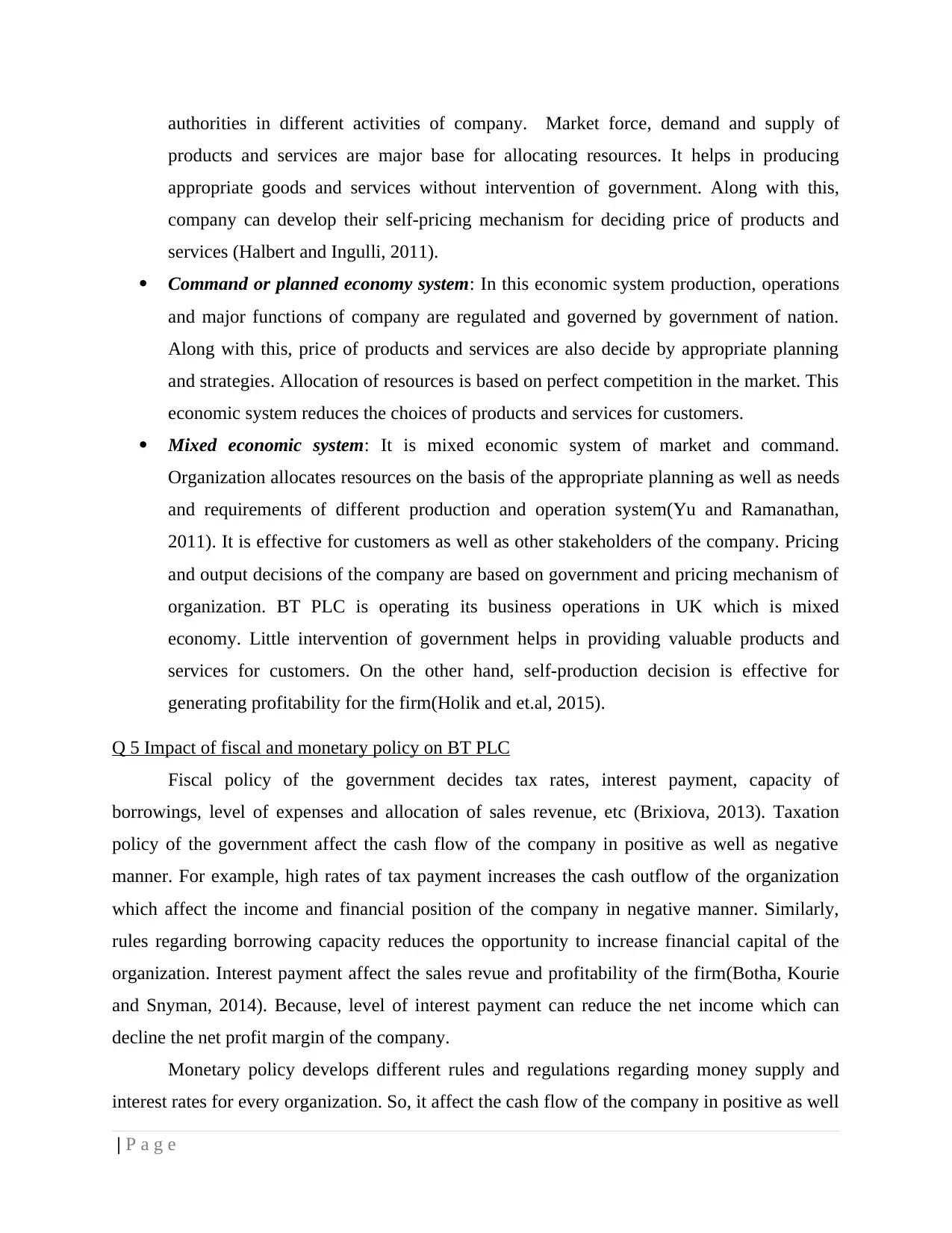
authorities in different activities of company. Market force, demand and supply of
products and services are major base for allocating resources. It helps in producing
appropriate goods and services without intervention of government. Along with this,
company can develop their self-pricing mechanism for deciding price of products and
services (Halbert and Ingulli, 2011).
Command or planned economy system: In this economic system production, operations
and major functions of company are regulated and governed by government of nation.
Along with this, price of products and services are also decide by appropriate planning
and strategies. Allocation of resources is based on perfect competition in the market. This
economic system reduces the choices of products and services for customers.
Mixed economic system: It is mixed economic system of market and command.
Organization allocates resources on the basis of the appropriate planning as well as needs
and requirements of different production and operation system(Yu and Ramanathan,
2011). It is effective for customers as well as other stakeholders of the company. Pricing
and output decisions of the company are based on government and pricing mechanism of
organization. BT PLC is operating its business operations in UK which is mixed
economy. Little intervention of government helps in providing valuable products and
services for customers. On the other hand, self-production decision is effective for
generating profitability for the firm(Holik and et.al, 2015).
Q 5 Impact of fiscal and monetary policy on BT PLC
Fiscal policy of the government decides tax rates, interest payment, capacity of
borrowings, level of expenses and allocation of sales revenue, etc (Brixiova, 2013). Taxation
policy of the government affect the cash flow of the company in positive as well as negative
manner. For example, high rates of tax payment increases the cash outflow of the organization
which affect the income and financial position of the company in negative manner. Similarly,
rules regarding borrowing capacity reduces the opportunity to increase financial capital of the
organization. Interest payment affect the sales revue and profitability of the firm(Botha, Kourie
and Snyman, 2014). Because, level of interest payment can reduce the net income which can
decline the net profit margin of the company.
Monetary policy develops different rules and regulations regarding money supply and
interest rates for every organization. So, it affect the cash flow of the company in positive as well
| P a g e
products and services are major base for allocating resources. It helps in producing
appropriate goods and services without intervention of government. Along with this,
company can develop their self-pricing mechanism for deciding price of products and
services (Halbert and Ingulli, 2011).
Command or planned economy system: In this economic system production, operations
and major functions of company are regulated and governed by government of nation.
Along with this, price of products and services are also decide by appropriate planning
and strategies. Allocation of resources is based on perfect competition in the market. This
economic system reduces the choices of products and services for customers.
Mixed economic system: It is mixed economic system of market and command.
Organization allocates resources on the basis of the appropriate planning as well as needs
and requirements of different production and operation system(Yu and Ramanathan,
2011). It is effective for customers as well as other stakeholders of the company. Pricing
and output decisions of the company are based on government and pricing mechanism of
organization. BT PLC is operating its business operations in UK which is mixed
economy. Little intervention of government helps in providing valuable products and
services for customers. On the other hand, self-production decision is effective for
generating profitability for the firm(Holik and et.al, 2015).
Q 5 Impact of fiscal and monetary policy on BT PLC
Fiscal policy of the government decides tax rates, interest payment, capacity of
borrowings, level of expenses and allocation of sales revenue, etc (Brixiova, 2013). Taxation
policy of the government affect the cash flow of the company in positive as well as negative
manner. For example, high rates of tax payment increases the cash outflow of the organization
which affect the income and financial position of the company in negative manner. Similarly,
rules regarding borrowing capacity reduces the opportunity to increase financial capital of the
organization. Interest payment affect the sales revue and profitability of the firm(Botha, Kourie
and Snyman, 2014). Because, level of interest payment can reduce the net income which can
decline the net profit margin of the company.
Monetary policy develops different rules and regulations regarding money supply and
interest rates for every organization. So, it affect the cash flow of the company in positive as well
| P a g e
Paraphrase This Document
Need a fresh take? Get an instant paraphrase of this document with our AI Paraphraser
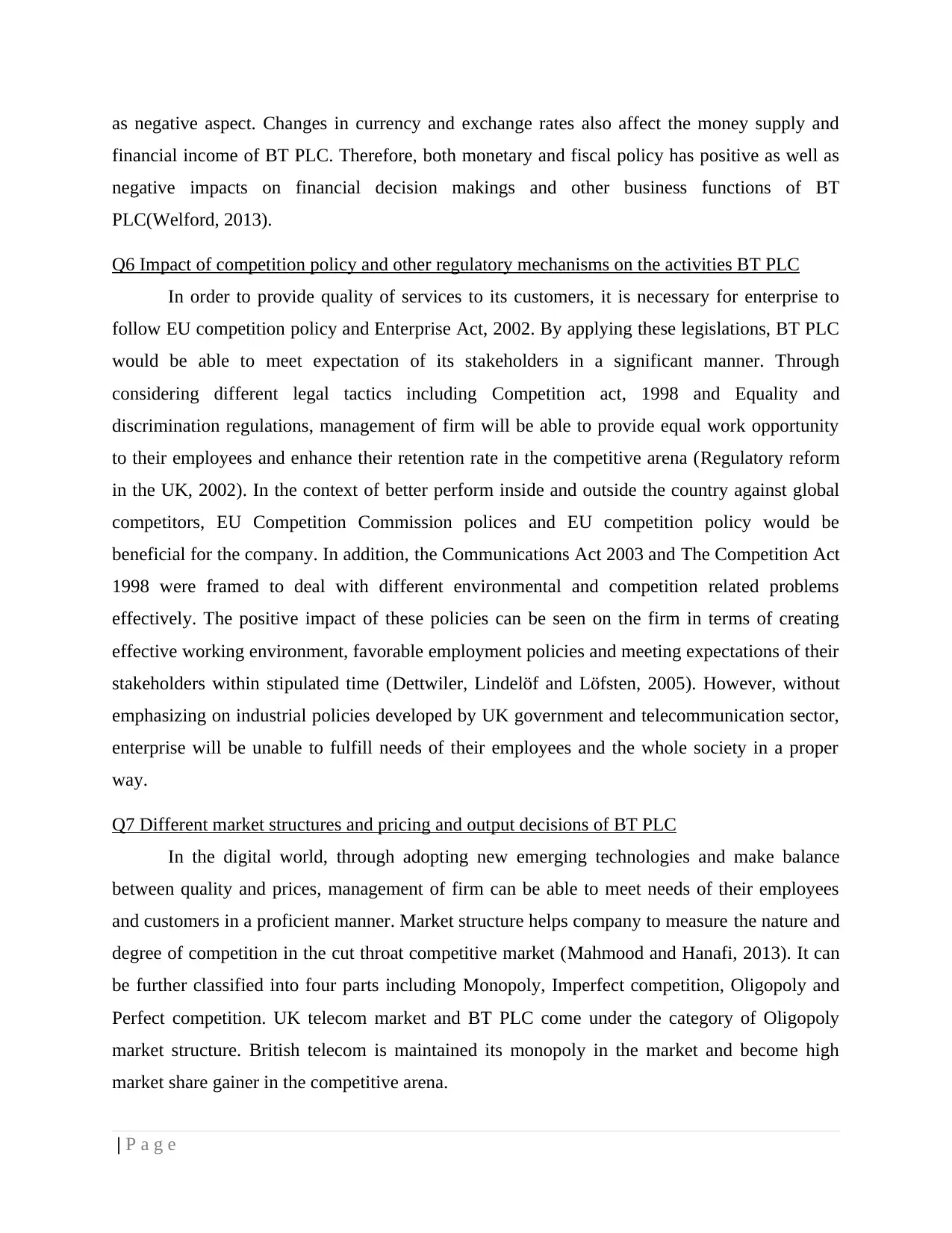
as negative aspect. Changes in currency and exchange rates also affect the money supply and
financial income of BT PLC. Therefore, both monetary and fiscal policy has positive as well as
negative impacts on financial decision makings and other business functions of BT
PLC(Welford, 2013).
Q6 Impact of competition policy and other regulatory mechanisms on the activities BT PLC
In order to provide quality of services to its customers, it is necessary for enterprise to
follow EU competition policy and Enterprise Act, 2002. By applying these legislations, BT PLC
would be able to meet expectation of its stakeholders in a significant manner. Through
considering different legal tactics including Competition act, 1998 and Equality and
discrimination regulations, management of firm will be able to provide equal work opportunity
to their employees and enhance their retention rate in the competitive arena (Regulatory reform
in the UK, 2002). In the context of better perform inside and outside the country against global
competitors, EU Competition Commission polices and EU competition policy would be
beneficial for the company. In addition, the Communications Act 2003 and The Competition Act
1998 were framed to deal with different environmental and competition related problems
effectively. The positive impact of these policies can be seen on the firm in terms of creating
effective working environment, favorable employment policies and meeting expectations of their
stakeholders within stipulated time (Dettwiler, Lindelöf and Löfsten, 2005). However, without
emphasizing on industrial policies developed by UK government and telecommunication sector,
enterprise will be unable to fulfill needs of their employees and the whole society in a proper
way.
Q7 Different market structures and pricing and output decisions of BT PLC
In the digital world, through adopting new emerging technologies and make balance
between quality and prices, management of firm can be able to meet needs of their employees
and customers in a proficient manner. Market structure helps company to measure the nature and
degree of competition in the cut throat competitive market (Mahmood and Hanafi, 2013). It can
be further classified into four parts including Monopoly, Imperfect competition, Oligopoly and
Perfect competition. UK telecom market and BT PLC come under the category of Oligopoly
market structure. British telecom is maintained its monopoly in the market and become high
market share gainer in the competitive arena.
| P a g e
financial income of BT PLC. Therefore, both monetary and fiscal policy has positive as well as
negative impacts on financial decision makings and other business functions of BT
PLC(Welford, 2013).
Q6 Impact of competition policy and other regulatory mechanisms on the activities BT PLC
In order to provide quality of services to its customers, it is necessary for enterprise to
follow EU competition policy and Enterprise Act, 2002. By applying these legislations, BT PLC
would be able to meet expectation of its stakeholders in a significant manner. Through
considering different legal tactics including Competition act, 1998 and Equality and
discrimination regulations, management of firm will be able to provide equal work opportunity
to their employees and enhance their retention rate in the competitive arena (Regulatory reform
in the UK, 2002). In the context of better perform inside and outside the country against global
competitors, EU Competition Commission polices and EU competition policy would be
beneficial for the company. In addition, the Communications Act 2003 and The Competition Act
1998 were framed to deal with different environmental and competition related problems
effectively. The positive impact of these policies can be seen on the firm in terms of creating
effective working environment, favorable employment policies and meeting expectations of their
stakeholders within stipulated time (Dettwiler, Lindelöf and Löfsten, 2005). However, without
emphasizing on industrial policies developed by UK government and telecommunication sector,
enterprise will be unable to fulfill needs of their employees and the whole society in a proper
way.
Q7 Different market structures and pricing and output decisions of BT PLC
In the digital world, through adopting new emerging technologies and make balance
between quality and prices, management of firm can be able to meet needs of their employees
and customers in a proficient manner. Market structure helps company to measure the nature and
degree of competition in the cut throat competitive market (Mahmood and Hanafi, 2013). It can
be further classified into four parts including Monopoly, Imperfect competition, Oligopoly and
Perfect competition. UK telecom market and BT PLC come under the category of Oligopoly
market structure. British telecom is maintained its monopoly in the market and become high
market share gainer in the competitive arena.
| P a g e
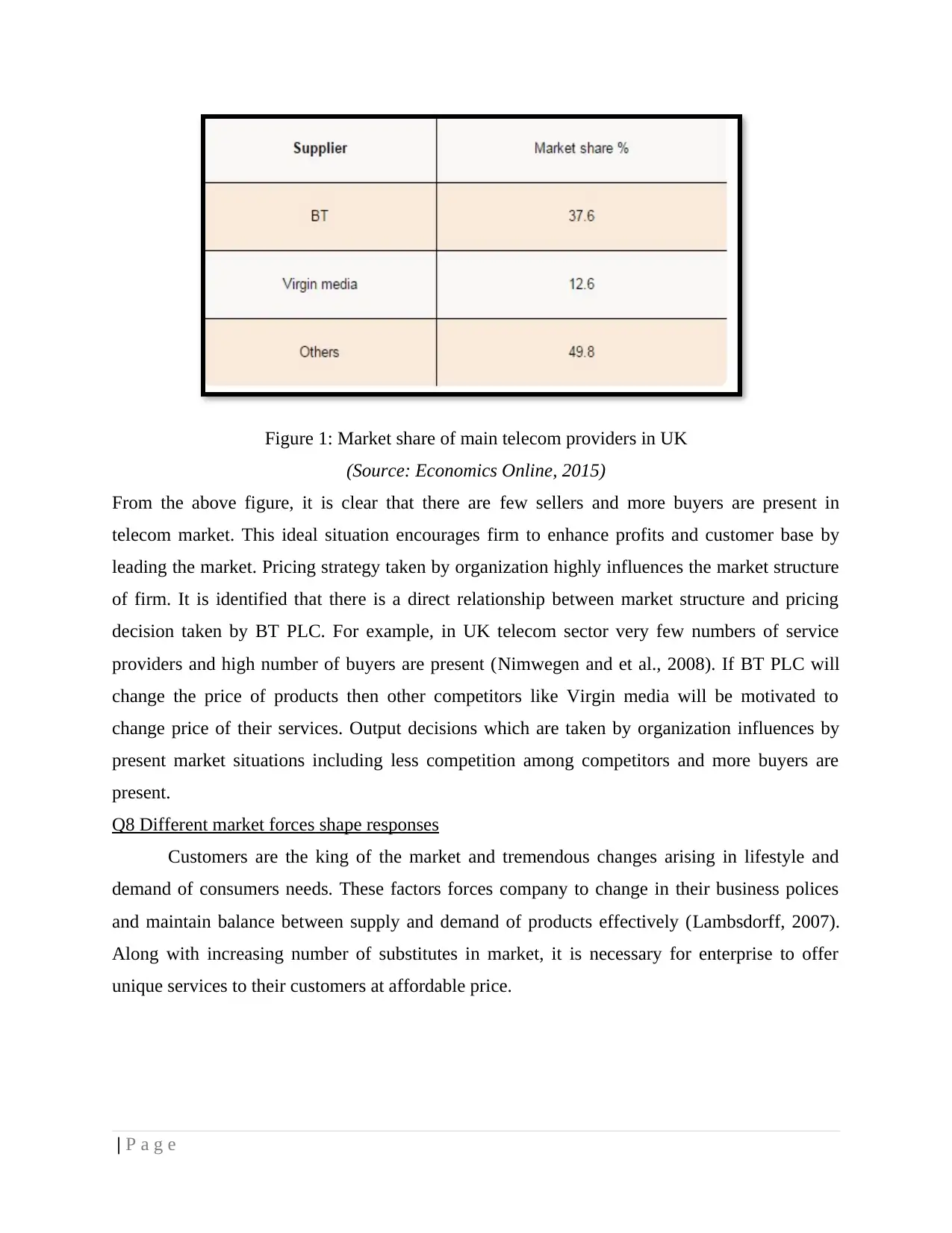
Figure 1: Market share of main telecom providers in UK
(Source: Economics Online, 2015)
From the above figure, it is clear that there are few sellers and more buyers are present in
telecom market. This ideal situation encourages firm to enhance profits and customer base by
leading the market. Pricing strategy taken by organization highly influences the market structure
of firm. It is identified that there is a direct relationship between market structure and pricing
decision taken by BT PLC. For example, in UK telecom sector very few numbers of service
providers and high number of buyers are present (Nimwegen and et al., 2008). If BT PLC will
change the price of products then other competitors like Virgin media will be motivated to
change price of their services. Output decisions which are taken by organization influences by
present market situations including less competition among competitors and more buyers are
present.
Q8 Different market forces shape responses
Customers are the king of the market and tremendous changes arising in lifestyle and
demand of consumers needs. These factors forces company to change in their business polices
and maintain balance between supply and demand of products effectively (Lambsdorff, 2007).
Along with increasing number of substitutes in market, it is necessary for enterprise to offer
unique services to their customers at affordable price.
| P a g e
(Source: Economics Online, 2015)
From the above figure, it is clear that there are few sellers and more buyers are present in
telecom market. This ideal situation encourages firm to enhance profits and customer base by
leading the market. Pricing strategy taken by organization highly influences the market structure
of firm. It is identified that there is a direct relationship between market structure and pricing
decision taken by BT PLC. For example, in UK telecom sector very few numbers of service
providers and high number of buyers are present (Nimwegen and et al., 2008). If BT PLC will
change the price of products then other competitors like Virgin media will be motivated to
change price of their services. Output decisions which are taken by organization influences by
present market situations including less competition among competitors and more buyers are
present.
Q8 Different market forces shape responses
Customers are the king of the market and tremendous changes arising in lifestyle and
demand of consumers needs. These factors forces company to change in their business polices
and maintain balance between supply and demand of products effectively (Lambsdorff, 2007).
Along with increasing number of substitutes in market, it is necessary for enterprise to offer
unique services to their customers at affordable price.
| P a g e
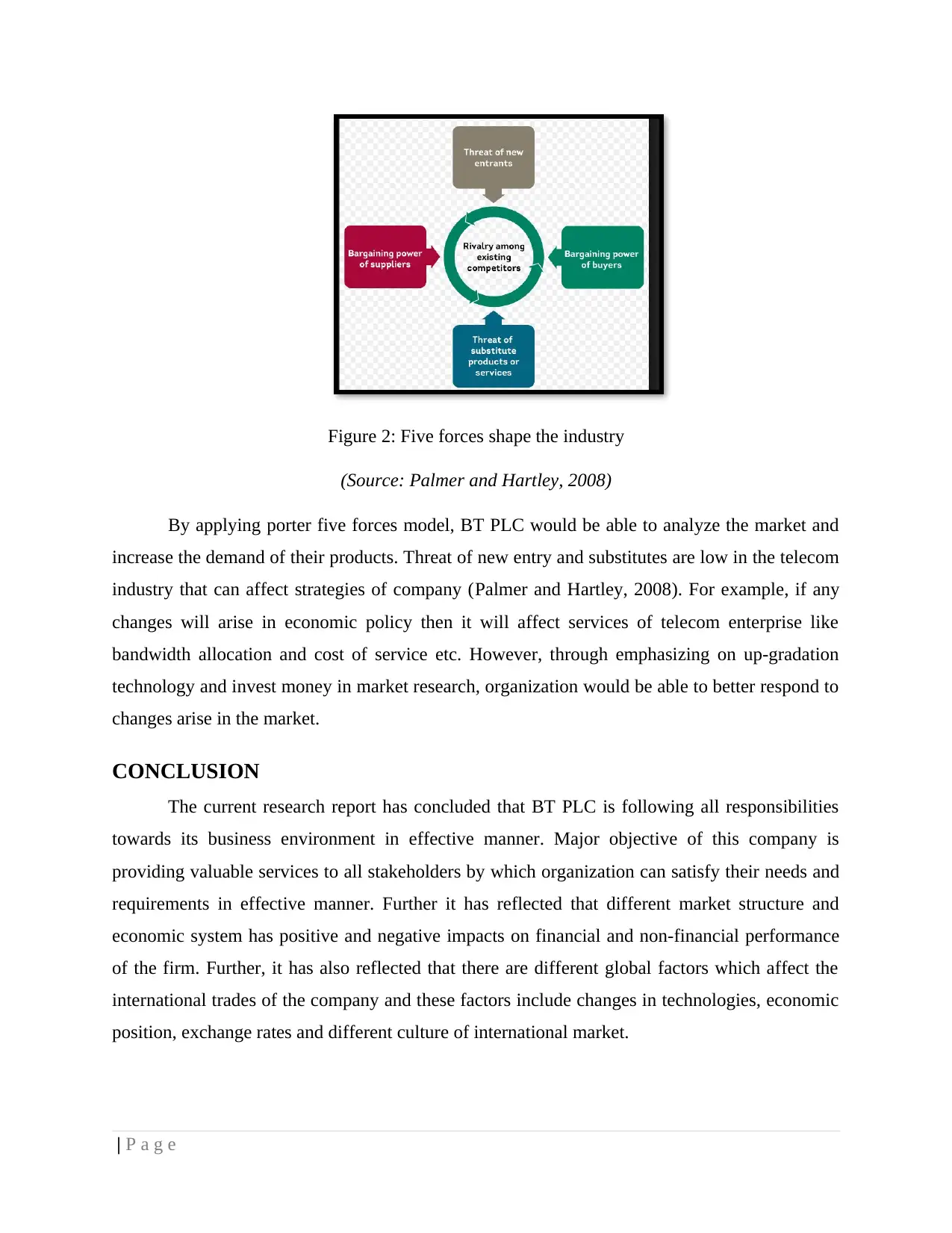
Figure 2: Five forces shape the industry
(Source: Palmer and Hartley, 2008)
By applying porter five forces model, BT PLC would be able to analyze the market and
increase the demand of their products. Threat of new entry and substitutes are low in the telecom
industry that can affect strategies of company (Palmer and Hartley, 2008). For example, if any
changes will arise in economic policy then it will affect services of telecom enterprise like
bandwidth allocation and cost of service etc. However, through emphasizing on up-gradation
technology and invest money in market research, organization would be able to better respond to
changes arise in the market.
CONCLUSION
The current research report has concluded that BT PLC is following all responsibilities
towards its business environment in effective manner. Major objective of this company is
providing valuable services to all stakeholders by which organization can satisfy their needs and
requirements in effective manner. Further it has reflected that different market structure and
economic system has positive and negative impacts on financial and non-financial performance
of the firm. Further, it has also reflected that there are different global factors which affect the
international trades of the company and these factors include changes in technologies, economic
position, exchange rates and different culture of international market.
| P a g e
(Source: Palmer and Hartley, 2008)
By applying porter five forces model, BT PLC would be able to analyze the market and
increase the demand of their products. Threat of new entry and substitutes are low in the telecom
industry that can affect strategies of company (Palmer and Hartley, 2008). For example, if any
changes will arise in economic policy then it will affect services of telecom enterprise like
bandwidth allocation and cost of service etc. However, through emphasizing on up-gradation
technology and invest money in market research, organization would be able to better respond to
changes arise in the market.
CONCLUSION
The current research report has concluded that BT PLC is following all responsibilities
towards its business environment in effective manner. Major objective of this company is
providing valuable services to all stakeholders by which organization can satisfy their needs and
requirements in effective manner. Further it has reflected that different market structure and
economic system has positive and negative impacts on financial and non-financial performance
of the firm. Further, it has also reflected that there are different global factors which affect the
international trades of the company and these factors include changes in technologies, economic
position, exchange rates and different culture of international market.
| P a g e
Secure Best Marks with AI Grader
Need help grading? Try our AI Grader for instant feedback on your assignments.
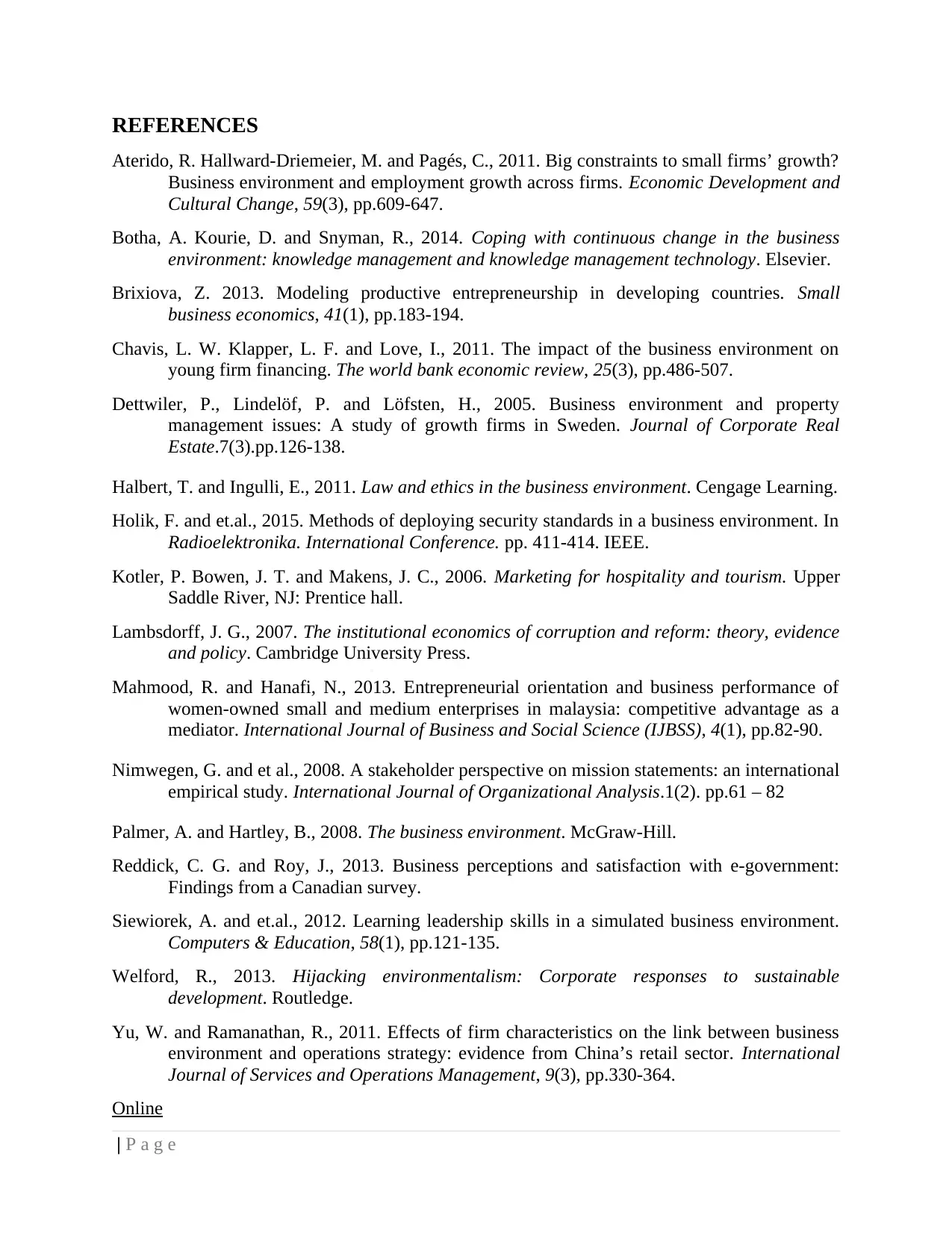
REFERENCES
Aterido, R. Hallward-Driemeier, M. and Pagés, C., 2011. Big constraints to small firms’ growth?
Business environment and employment growth across firms. Economic Development and
Cultural Change, 59(3), pp.609-647.
Botha, A. Kourie, D. and Snyman, R., 2014. Coping with continuous change in the business
environment: knowledge management and knowledge management technology. Elsevier.
Brixiova, Z. 2013. Modeling productive entrepreneurship in developing countries. Small
business economics, 41(1), pp.183-194.
Chavis, L. W. Klapper, L. F. and Love, I., 2011. The impact of the business environment on
young firm financing. The world bank economic review, 25(3), pp.486-507.
Dettwiler, P., Lindelöf, P. and Löfsten, H., 2005. Business environment and property
management issues: A study of growth firms in Sweden. Journal of Corporate Real
Estate.7(3).pp.126-138.
Halbert, T. and Ingulli, E., 2011. Law and ethics in the business environment. Cengage Learning.
Holik, F. and et.al., 2015. Methods of deploying security standards in a business environment. In
Radioelektronika. International Conference. pp. 411-414. IEEE.
Kotler, P. Bowen, J. T. and Makens, J. C., 2006. Marketing for hospitality and tourism. Upper
Saddle River, NJ: Prentice hall.
Lambsdorff, J. G., 2007. The institutional economics of corruption and reform: theory, evidence
and policy. Cambridge University Press.
Mahmood, R. and Hanafi, N., 2013. Entrepreneurial orientation and business performance of
women-owned small and medium enterprises in malaysia: competitive advantage as a
mediator. International Journal of Business and Social Science (IJBSS), 4(1), pp.82-90.
Nimwegen, G. and et al., 2008. A stakeholder perspective on mission statements: an international
empirical study. International Journal of Organizational Analysis.1(2). pp.61 – 82
Palmer, A. and Hartley, B., 2008. The business environment. McGraw-Hill.
Reddick, C. G. and Roy, J., 2013. Business perceptions and satisfaction with e-government:
Findings from a Canadian survey.
Siewiorek, A. and et.al., 2012. Learning leadership skills in a simulated business environment.
Computers & Education, 58(1), pp.121-135.
Welford, R., 2013. Hijacking environmentalism: Corporate responses to sustainable
development. Routledge.
Yu, W. and Ramanathan, R., 2011. Effects of firm characteristics on the link between business
environment and operations strategy: evidence from China’s retail sector. International
Journal of Services and Operations Management, 9(3), pp.330-364.
Online
| P a g e
Aterido, R. Hallward-Driemeier, M. and Pagés, C., 2011. Big constraints to small firms’ growth?
Business environment and employment growth across firms. Economic Development and
Cultural Change, 59(3), pp.609-647.
Botha, A. Kourie, D. and Snyman, R., 2014. Coping with continuous change in the business
environment: knowledge management and knowledge management technology. Elsevier.
Brixiova, Z. 2013. Modeling productive entrepreneurship in developing countries. Small
business economics, 41(1), pp.183-194.
Chavis, L. W. Klapper, L. F. and Love, I., 2011. The impact of the business environment on
young firm financing. The world bank economic review, 25(3), pp.486-507.
Dettwiler, P., Lindelöf, P. and Löfsten, H., 2005. Business environment and property
management issues: A study of growth firms in Sweden. Journal of Corporate Real
Estate.7(3).pp.126-138.
Halbert, T. and Ingulli, E., 2011. Law and ethics in the business environment. Cengage Learning.
Holik, F. and et.al., 2015. Methods of deploying security standards in a business environment. In
Radioelektronika. International Conference. pp. 411-414. IEEE.
Kotler, P. Bowen, J. T. and Makens, J. C., 2006. Marketing for hospitality and tourism. Upper
Saddle River, NJ: Prentice hall.
Lambsdorff, J. G., 2007. The institutional economics of corruption and reform: theory, evidence
and policy. Cambridge University Press.
Mahmood, R. and Hanafi, N., 2013. Entrepreneurial orientation and business performance of
women-owned small and medium enterprises in malaysia: competitive advantage as a
mediator. International Journal of Business and Social Science (IJBSS), 4(1), pp.82-90.
Nimwegen, G. and et al., 2008. A stakeholder perspective on mission statements: an international
empirical study. International Journal of Organizational Analysis.1(2). pp.61 – 82
Palmer, A. and Hartley, B., 2008. The business environment. McGraw-Hill.
Reddick, C. G. and Roy, J., 2013. Business perceptions and satisfaction with e-government:
Findings from a Canadian survey.
Siewiorek, A. and et.al., 2012. Learning leadership skills in a simulated business environment.
Computers & Education, 58(1), pp.121-135.
Welford, R., 2013. Hijacking environmentalism: Corporate responses to sustainable
development. Routledge.
Yu, W. and Ramanathan, R., 2011. Effects of firm characteristics on the link between business
environment and operations strategy: evidence from China’s retail sector. International
Journal of Services and Operations Management, 9(3), pp.330-364.
Online
| P a g e
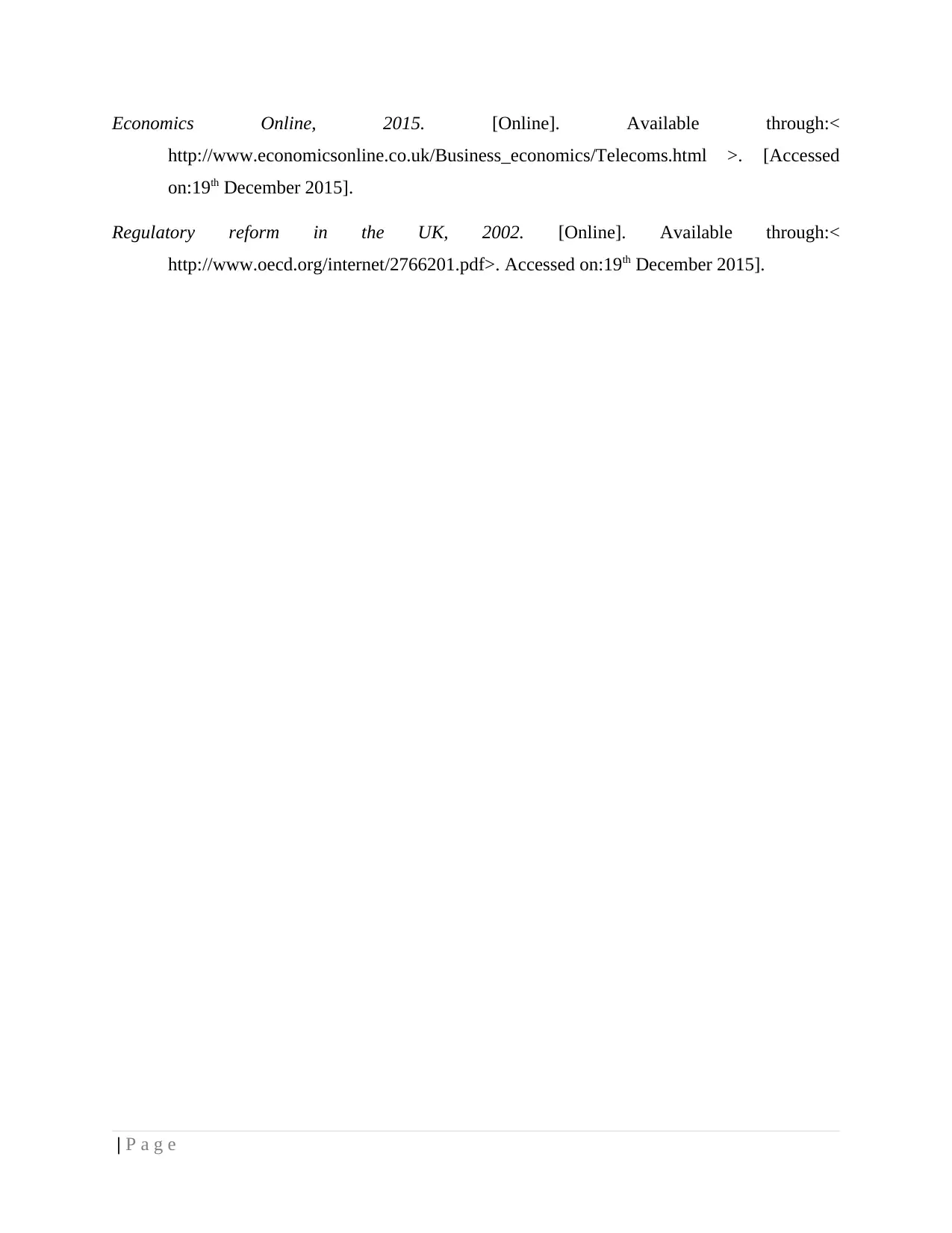
Economics Online, 2015. [Online]. Available through:<
http://www.economicsonline.co.uk/Business_economics/Telecoms.html >. [Accessed
on:19th December 2015].
Regulatory reform in the UK, 2002. [Online]. Available through:<
http://www.oecd.org/internet/2766201.pdf>. Accessed on:19th December 2015].
| P a g e
http://www.economicsonline.co.uk/Business_economics/Telecoms.html >. [Accessed
on:19th December 2015].
Regulatory reform in the UK, 2002. [Online]. Available through:<
http://www.oecd.org/internet/2766201.pdf>. Accessed on:19th December 2015].
| P a g e
1 out of 12
Related Documents
Your All-in-One AI-Powered Toolkit for Academic Success.
+13062052269
info@desklib.com
Available 24*7 on WhatsApp / Email
![[object Object]](/_next/static/media/star-bottom.7253800d.svg)
Unlock your academic potential
© 2024 | Zucol Services PVT LTD | All rights reserved.





